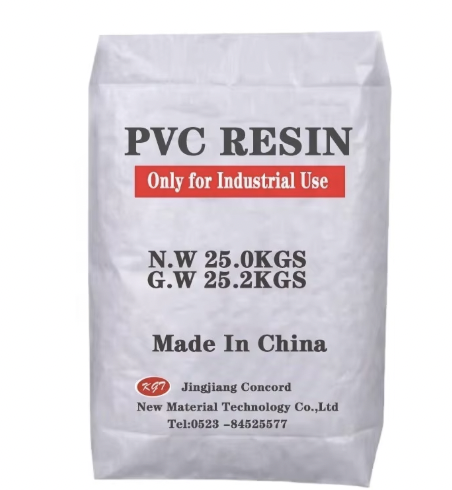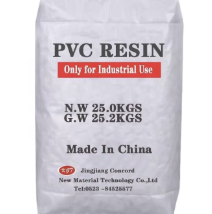이해 PVC 수지 구성물과 재료 안전성
수지 등급이 강도와 내구성에 미치는 영향
PVC 수지에는 강성, 유연성 및 충격 개질된 수지와 같은 다양한 형태가 있으며, 각각 고유한 기계적 특성과 가공 성능을 가지고 있습니다. 강성 PVC의 높은 인장 강도는 파이프와 창틀과 같은 응용 분야에서 완벽하게 사용될 수 있습니다. 유연한 PVC는 부드러운 유형으로 약간 더 유연한 고무 혼합물로 구성되어 있어 더 많이 늘어날 수 있습니다. 고충격 PVC는 혹독한 환경에 대한 저항성을 제공하면서 견고함과 내구성을 제공합니다. 이 값은 PVC의 종류에 따라 다를 수 있습니다 (강성 PVC는 약 52 MPa까지 도달할 수 있고 유연한 유형은 10-50 MPa 범위 내에서 제한됩니다) (ASTM). 또한 제품의 다른 등급에도 영향을 미칠 수 있으며, 이는 고충격 PVC가 경쟁 제품보다 더 날씨에 강한 실외 표지판에서의 성공적인 사용으로 입증되었습니다.
강성 및 처리 효율성을 위한 K-값 선택
더 중요한 것은, K-값이 PVC 수지의 점도와 가공 특성에 큰 영향을 미치는 요소라는 것이다. 기본적으로 K-값은 수지 내부의 중합물 수에 대한 평균 구성을 나타낸다. 응용 분야 선택: 적절한 K-값은 최종 제품이 요구하는 강성과 가공성에 따라 달라질 수 있다. 낮은 K-값은 더 유동성이 높은 수지를 의미하며, 고유량 주사 성형에 더 적합하다. 반면, 높은 K-값은 더 단단한 특성을 가지는 제품에 적합하여 기계적 특성이 중요한 응용 분야에서 선호된다. 예를 들어, 57-60 범위의 K-값은 좋은 강성과 용이한 가공성을 갖춘 튼튼한 파이프를 생산하기에 적합하다. 이러한 표준들은 전 세계 산업과 기업들이 제품과 서비스의 품질을 유지하고 구조적 안정성과 효율성을 극대화할 수 있도록 돕는다.
독성 및 환경 안전에 영향을 미치는 첨가제
PVC 제조 과정에서는 가소제, 안정제, 충전제와 같은 첨가제의 사용이 제품 안전성과 환경 영향 모두에 있어 중요한 역할을 합니다. 가소제는 유연성을 향상시키기 위해 사용되지만 적절히 관리되지 않을 경우 독성의 원인이 될 수 있습니다. 안정제는 내열성과 안정성을 높여주며, 충전제는 물리적 특성과 경제성을 조절합니다. 일부 첨가제는 건강에 잠재적으로 부정적인 영향을 줄 수 있는 것으로 나타났기 때문에 선택과 규제는 신중하게 진행되어야 합니다. 프탈레이트(phthalates)와 중금속 안정제 최근 들어 일부 프탈레이트와 중금속 안정제의 독성에 대한 관심이 증가하고 있습니다. 안전성을 보장하기 위해 제조사들은 무독성이고 친환경적인 첨가제를 사용해야 하며 국제 규격을 준수해야 합니다. 모범 사례로는 보다 지속 가능한 원료를 개발하고 과도한 사용을 줄여 현재의 안전 기준 내에서 환경적 영향을 최소화하는 것입니다.
식품 접촉 용도에 대한 FDA 규정 준수
FDA 규정에 준수하는 것은 음식 접촉 작업에서 사용되는 PVC 제품의 안전성을 유지하는 데 있어 매우 중요합니다. FDA의 연방 규제 코드는 음식 접촉 용도로 PVC를 사용하기 위한 허가를 얻기 위해 충족해야 할 엄격한 가이드라인을 설정하고 있습니다. 제조업체들은 광범위한 승인 절차를 거치며, 이는 매우 철저한 테스트와 방대한 문서화 과정을 포함하며, 우리는 우리의 PVC 제품이 음식과 매우 밀접하게 사용될 때에도 안전하다는 것을 입증해야 합니다. 산업 통계에 따르면 제조업체들 사이에서 규정 준수가 크게 다르며, 일부는 준수하지 않을 경우 처벌을 받을 수 있으며, 이를테면 리콜이나 금지 조치가 있을 수 있습니다. 사례 연구를 검토함으로써 FDA 가이드라인에 계속 준수하는 것이 얼마나 중요한지를 알 수 있으며, 그렇지 않으면 벌금 부과와 소비자 신뢰 상실 위험에 직면할 수 있습니다.
EU REACH 화학물질 안전 프로토콜
REACH는 유럽 연합(EU)의 화학물질에 대한 정보를 종합하고 이해하는 시스템으로, EU 내 PVC 생산 및 사용에 큰 영향을 미칩니다. 이 시스템은 포괄적인 화학 안전 검사를 요구하며, PVC 응용에 사용되는 물질들이 적절히 등록되도록 합니다. 이는 유럽 전역의 화학 안전성을 향상시키고 위험 물질이 사람들과 환경에 미치는 위험을 줄이기 위한 노력입니다. 이는 제조업체들에게 변경되는 표준에 맞추어 자료 안전 데이터를 업데이트하고 유지하는 데 비용과 시간이 많이 들 수 있습니다. REACH의 복잡성은 운영 부담과 비용 부담을 초래할 수 있으며, 이러한 요구 사항들은 단순히 제조 과정에서만이 아니라 PVC 산업 전반에 걸쳐 매우 엄격한 요구를 제시하며, 화학 안전과 동등한 책임을 강조합니다. 또한 환경 관리와 제품 분배 측면에서도 중요한 유도 작용을 합니다.
전기 배관 시스템의 UL 인증
Underwriters Laboratories (UL) 규정 준수는 전기 채널용 PVC에서 필수적입니다. UL 514B와 같은 주요 표준은 이러한 서비스에서 PVC의 성능과 신뢰성에 대한 요구 사항을 정의합니다. UL 인증을 획득하면 제품이 안전하다는 것을 입증하고, 비준수 재료로 인해 발생할 수 있는 전기 고장의 위험을 줄일 수 있습니다. 많은 제조업체들이 UL과 함께 잘 발전했으며, 공공 이미지 향상과 책임 감소에서 많은 이익을 얻었습니다. 이것은 특히 안전하고 신뢰할 수 있는 재료가 필수인 전기 산업에서 extremely 중요합니다.
음용수 파이프를 위한 NSF 표준
NSF 표준에 따라 식수 용도로 PVC의 사용은 환경 보호청(EPA)을 포함한 다양한 기관들에 의해 의문시되고 있다. 이는 모든 수질에 대해 화학적으로 안정적이지 않고, 뜨거운 물 용도로 등급이 지정되지 않았기 때문이다. 이러한 표준은 주로 유출물 테스트를 기반으로 한 시험 절차와 승인 기준을 설정하여 PVC 파이프로 인해 물이 오염되는 것을 방지하려 한다. 만약 국가 위생 재단(NSP)의 표준을 충족하지 못할 경우 발생할 수 있는 위험을 고려할 때 이러한 예방 조치는 더욱 필수적이다. 표준을 준수하지 않을 경우 공중 보건에 심각한 결과가 초래될 수 있다. 제조업체들은 인간이 마실 수 있는 안전한 물을 운반하기 위해 이러한 모든 가이드라인을 엄격히 준수해야 한다. 준수 실패는 이러한 교정 기준들을 간과함으로써 발생할 수 있는 위험을 부각시키며, NSF 표준에 대한 엄격한 준수의 중요성을 강조한다.
EU의 2024년 PVC 납 단계적 폐지 규정 분석
2024년에 시행될 예정인 유럽연합(EU)의 PVC 제품 내 납 규제는 공중보건을 보호하기 위한 중요한 조치입니다. 납 노출은 신경계와 발달에 미치는 영향 등 어린이에게 심각한 건강 위험을 초래할 수 있음이 오랫동안 알려져 왔습니다. 다행스러운 점은 EU의 새로운 지침이 제조업체들이 유럽 시장 진입을 위해 PVC에서 납을 제거하고 이러한 요구를 충족하기 위해 혁신하도록 촉구한다는 것입니다. PVC가 사용되는 산업들은 주어진 기간 내에 이를 준수해야 하며, 2024년 이전에 규정을 준수하지 않을 경우 비즈니스 운영에 극도로 큰 어려움을 겪게 될 정도로 처벌이나 시장 접근 제한이 매우 엄격할 것입니다.
칼슘-아연 안정제는 실용적인 대체물로 활용 가능
EU가 PVC에서 납을 포함한 안정제를 금지함에 따라 칼슘-아연 안정제는 전체적인 탄소 발자국이 더 낮고 다양한 환경 및 건강 이점이 있는 실용적인 대안을 제공합니다. 이러한 안정제는 유해한 납 기반 제품을 대체하여 성능은 유지하면서도 비유해성과 생태친화적인 대안을 제공합니다. 그들은 전통적인 안정제와 동등한 열적 안정성과 가공 성능을 가지고 있습니다. 여러 제조업체들은 시장에서 펠렛의 개선된 안전성과 수용도를 보여주는 다수의 사례 연구에서 성공적으로 칼슘-아연 시스템으로 전환했습니다. 이러한 변화들은 규칙을 준수하는 동시에 소비자들이 더 안전하고 지속 가능한 제품에 대한 요구가 증가하고 있음을 반영합니다.
재생 PVC 준수 과제
재생 PVC가 납 함량 제한을 충족하는지 확인하는 데는 고유한 도전 과제들이 있습니다. 현대적인 재활용 기술에 따라 재생 재료의 안전성을 검증하는 것은 기술적으로 복잡합니다. 납 오염을 감지하고 제거하기 위한 실용적인 방법도 이러한 규정 준수를 위해 가능합니다. 지속적인 연구들은 이러한 문제를 해결하기 위해 설계된 재활용 기술의 발전에 주목하고 있습니다. 철저한 안전 점검과 고급 재활용 기술에 대한 투자는 제조업체들이 납 제한을 준수하고 더 큰 시장에 접근하며, 지속 가능한 생산 프로세스를 지원하는 데 도움이 될 것입니다.
의료기기 제조: USP Class VI 준수
의료 제품에 사용되는 PVC 기반 재료는 안전하고 효과적이려면 USP Class VI 규격에 부합해야 합니다. 이러한 적합성은 엄격한 세포독성 시험 및 기타 시험을 통해 입증되며, 이는 재료가 인체 건강에 위험을 초래하지 않음을 보장합니다. 예시 연구를 통해 우리는 유연한 PVC가 catheters나 blood bags와 같은 생명 유지에 중요한 제품에서 신뢰성 있고 임상적으로 안전하게 사용된다는 점도 강조합니다. 이러한 규정에 준수하는 것은 의료 시장에 진입하려는 제조업체들에게 필수적이며, 요구 사항을 충족하지 못할 경우 높은 손해배상 책임이 발생하고 핵심 건강 제품의 시장 진입이 제한될 수 있습니다.
음용수 시스템: NSF/ANSI 61 인증
NSF/ANSI 61 인증은 PVC 식수 시스템 부품에 있어 필수적이며, 제품이 음용수에 유해한 오염 물질을 방출하지 않도록 보장합니다. 이는 건강 안전성을 확인하고 재료가 지속적으로 물에 접촉해도 적합한지를 검사하기 위한 엄격한 테스트를 포함합니다. 일부 사례 연구에서 드러난 바와 같이, 비준수 재료는 인간 건강에 심각한 영향을 미칠 수 있으며, 특히 식수 배급 네트워크의 일부가 오염된 경우 매우 유해할 수 있습니다. 재료 인증은 공중 보건을 보호하고, 지역 사회를 잠재적 위험으로부터 지키며, 모든 사람에게 안전한 식수를 보장하는 데 중요합니다.
건설 자재: 화재 안전 등급
화재 시 불길의 확산과 연기 발생에 있어 건축 자재로 사용되는 PVC의 방화 안전성은 특히 중요합니다. 안전 단체들의 자료에 따르면 재료를 부적절하게 사용할 경우 화재가 더 자주 발생할 수 있으며, 이는 표준을 준수하는 것이 중요한 이유입니다. PVC 재료의 방화 성능은 일부 재료들이 저항성을 나타내면서도 여전히 규격에 부합하도록 개선되었습니다. 이러한 발전으로 인해 엄격한 방화 기준을 충족하는 PVC 재료의 사용이 건축에서 생명과 재산을 보호하기 위한 중요성이 더욱 강조되고 있습니다.

독성 감소를 위한 생물 기반 가소제
하지만 생분해성 플라스티저의 발전은 인체에 해로운 영향을 줄 수 있는 것으로 의심받아온 프탈레이트 대신 안전한 대안을 제공하며 PVC 안전성 향상에 혁신적인 변화를 가져오고 있습니다. 과학자들은 독성이 낮은 생물 기반 대안을 연구하고 있으며, 일부 생물 기반 플라스티저의 성능은 유연성과 내구성을 유지하는 데 있어 인상적이며, 제품의 전반적인 안전성도 크게 향상됩니다. 실제로 일부 기업들은 이미 이러한 대안들을 생산 라인에 도입하여 시장에서의 제품 수용도가 증가하고 있습니다.
분자적으로 정렬된 PVC(PVC-O) 발전
분자배향 PVC(PVC-O)는 향상된 기계적 성능, 내구성 및 환경적 이점을 갖춘 차세대 PVC 파이프 기술이며, 사용 중 실제로 가장 우수한 환경성능을 발휘합니다. 전 세계적으로 거의 모든 다른 배관 재료에 비해 글로벌 워밍 포텐셜(GWP), 산성화 포텐셜(AP) 및 오존 영향 지수(ECI)가 현저히 낮습니다. PVC-O에 대한 수요 증가는 기존의 일반적인 PVC 대체재를 대신해 보다 높은 성능이 요구되는 파이프, 튜빙 및 건축 자재와 같은 용도에서의 사용 증가에 기인합니다. 조사에 따르면 PVC-O는 충격 강도 및 인장 강도가 높아 까다로운 응용 분야에 적합한 소재로 평가되고 있습니다. 또한 적은 재료 사용량과 긴 수명 등 지속 가능성 측면에서의 장점이 산업 전반에 걸쳐 수요를 촉진시키고 있습니다.
공급망 투명성을 위한 디지털 추적
디지털 모니터링 솔루션은 PVC 산업에서 혁신을 이루기 위해 공급망의 투명성을 높이는 데 중요한 역할을 하고 있습니다. 이러한 기술들은 추적 가능성이 강화되고 책임이 분명해지는 이점도 제공하며, 이는 공급망의 모든 단계가 안전 및 품질 규정을 준수하고 있음을 보장합니다. 사례 연구들은 디지털 추적이 어떻게 안전 규제 준수를 유지하고, PVC 생산 과정에서의 비준수 위험을 최소화하는지를 보여줍니다. 향후에는 업계가 제품 안전성과 지속 가능성을 확인하기 위해 점차적으로 디지털 기술을 도입할 것이며, 이는 향후 PVC 운영에서 예상되는 중요한 역할임을 설명하는 자료에 명시되어 있습니다.
자주 묻는 질문
주요 PVC 수지 등급은 무엇인가요?
PVC 수지 등급에는 단단하고, 유연하고, 충격에 강한 종류가 있으며, 각각 다른 응용 분야에 맞게 고유한 기계적 특성과 성능상의 이점을 제공합니다.
K-값이 PVC 수지에서 왜 중요한가요?
K-값은 PVC 수지의 점도와 가공 특성을 결정하며, 다양한 산업 응용 분야에서의 강성과 제조 공정의 용이성을 영향을 미칩니다.
첨가제가 PVC의 안전성과 환경적 영향에 어떻게 영향을 미치나요?
증점제, 안정제 및 충진제와 같은 첨가제는 PVC의 안전성과 환경적 풋프린트에 영향을 미칩니다. 건강 위험을 최소화하고 규제 기준을 준수하기 위해 친환경 대체물을 선택하는 것이 중요합니다.
EU의 2024년 PVC 납 단계적 폐지 규정은 무엇인가요?
EU는 2024년까지 PVC에서 납 함유량을 단계적으로 폐지하여 공중 보건을 보호하려고 하며, 제조업체들은 칼슘-아연과 같은 대체 안정제를 채택해야 합니다.
UL 인증이 전기 응용 분야에서의 PVC에 어떤 역할을 하나요?
UL 인증은 전기 배관 시스템에서의 PVC의 안전성을 보장하며, 제품 신뢰성을 검증하고 전기 고장의 위험을 줄입니다.
생물 기반 증점제가 PVC 안전 혁신에 어떻게 이익을 가져다주나요?
바이오 기반 가소제는 전통적인 프탈레이트에 비해 독성이 줄어들어 유연성과 제품 안전성을 향상시키면서도 성능에는 영향을 주지 않습니다.
Table of Contents
-
이해 PVC 수지 구성물과 재료 안전성
- 수지 등급이 강도와 내구성에 미치는 영향
- 강성 및 처리 효율성을 위한 K-값 선택
- 독성 및 환경 안전에 영향을 미치는 첨가제
- 식품 접촉 용도에 대한 FDA 규정 준수
- EU REACH 화학물질 안전 프로토콜
- 전기 배관 시스템의 UL 인증
- 음용수 파이프를 위한 NSF 표준
- EU의 2024년 PVC 납 단계적 폐지 규정 분석
- 칼슘-아연 안정제는 실용적인 대체물로 활용 가능
- 재생 PVC 준수 과제
- 의료기기 제조: USP Class VI 준수
- 음용수 시스템: NSF/ANSI 61 인증
- 건설 자재: 화재 안전 등급
- 독성 감소를 위한 생물 기반 가소제
- 분자적으로 정렬된 PVC(PVC-O) 발전
- 공급망 투명성을 위한 디지털 추적
- 자주 묻는 질문

